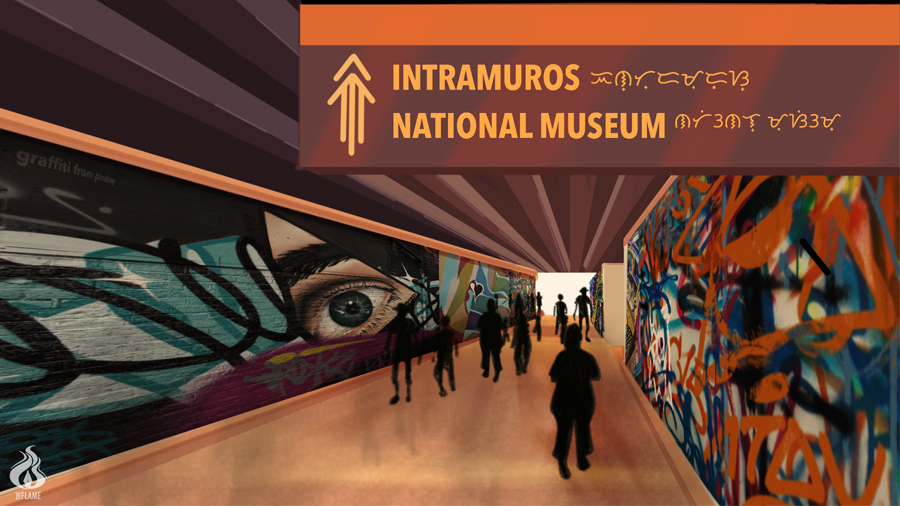
THE RENOVATION of the Lagusnilad underpass aimed to capture an ancient part of Filipino culture in its reopening two years ago, replacing cracks with signages that include Baybayin characters and their English transliteration.
Baybayin, an ancient writing script of the Philippines rooted in the pre-colonial period, met the heavy foot traffic of modern Manila, sparking the question of its use.
To others, a nuisance; and to others, a homage. The Flame asked experts if these texts represent aesthetics or appreciation.
Attention Commuters
Djhaemy Nazareno, an instructor who taught Baybayin to senior high school students in La Consolacion College, expressed her concern about the confusion the script may give to passersby.
“[Baybayin texts] shouldn’t be placed in public places without the proper reinforcement or proper education someone should have regarding the Pre-colonial Philippines, our culture, and Baybayin itself,” Nazareno told The Flame
As someone who frequently passes by the Lagusnilad underpass, Universidad de Manila Psychology student Kylo Velonza echoed Nazareno’s sentiments, saying its sudden appearance caused confusion to commuters as they did not understand the texts.
However, Velonza approved the usage of Baybayin texts in signages as long as their English or Filipino transliteration is present.
Aside from causing confusion, the signages also drew flak for being misused.
“Baybayin should be used with the Filipino language because that’s how the word Baybayin originated. Kung paanong binibigkas, siya ang baybay (It is written how it is spoken),” Nazareno said.
Regarding its accuracy, Ateneo de Manila University Filipino studies lecturer and currently finishing his Master’s degree in Philippine Studies Harvey Castillo did not think there was something wrong with the usage.
“Baybayin is a way of writing utilized by our ancestors that lived by the seashores, hence, Baybayin. If by correctness we mean usage form—we could say it’s correct. But if by correctness we mean the placement of such supposedly archipelagic coastline texts on a place we consider urban—then there is definitely confusion,” Castillo said.
Stop. Learn. Listen
Velonza admitted that he did not immediately notice the Baybayin texts.
“When I saw it, it did bring curiosity. I wanted to learn and understand it,” Velonza said.
Velonza, albeit curious, said he does not have time to learn Baybayin on his own.
Resources to understand Baybayin as a writing system are insufficient, according to Tala Kina*, a time arts major at Northern Illinois University and founder of Facebook group Eskripto ng Katagalugan (ENK).
“There are a lot of people who have misunderstood the original Baybayin from the modern Baybayin scripts. When they start to learn [modern Baybayin scripts] instead, confusion begins,” Tala Kina said.
Tala Kina has encountered people from different age groups interested in learning Baybayin. Beginning as a group chat of three people, the community has grown to 2000 people that share the want to learn Baybayin
As a self-taught Baybayin enthusiast, Tala Kina saw that it is only fit to normalize the use of Baybayin, especially in public spaces where people can accustom themselves through time.
“In my opinion, the script being used in public spaces for it to be revived and normalized is important, using it for products and creating designs to make it aesthetically pleasing is not that bad either,” Tala Kina said.
“As long as the public sees Baybayin as a writing script and not just for decorations then it is completely acceptable.”
Meanwhile, Castillo said it is not enough to just use Baybayin for beautification, especially to hide criminality and poverty.
“Beautification projects have always been a band-aid solution to give the illusion of cohesiveness, to give the illusion of stability and hide the prolonged economic and political crisis,” Castillo told The Flame.
Castillo commended the rehabilitation of urban spaces such as the Lagusnilad underpass. However, he urged the local government to stay committed to sustaining the space—not only beautifying it.
“Local governments should focus on providing a sense of culture, providing social services, and assurance to street vendors. The drainage system, the ease of transport around Lagusnilad—these are the things that the government should focus on after much beautification,” Castillo said.
Appreciation or Aesthetic
The presence of Baybayin texts in public spaces serves both its appreciation and aesthetic purposes.
“The trend of Baybayin texts in public spaces is a mixture of good and bad attention, in some way, it is good that our Pre-colonial history is being talked about, but it is not properly introduced to the citizens,” Nazareno said.
Castillo adds that learning Baybayin could be a good thing. “If it were to serve as a springboard in piquing the people’s interest for their pre-colonial roots and in supporting existing indigenous communities, then its purpose is a good thing,”.
But Castillo emphasized that the revival of Baybayin for the sake of invoking nationalism is not enough.
“If we are really to conserve our heritage, if we want to highlight Baybayin significance, then what we must do is protect currently existing indigenous communities. The issue is not whether Baybayin should be used. We could learn it but do we stop there?” he said. F – Katrizha Caye De Leon
* The Flame used a different name as per the request of the source.



